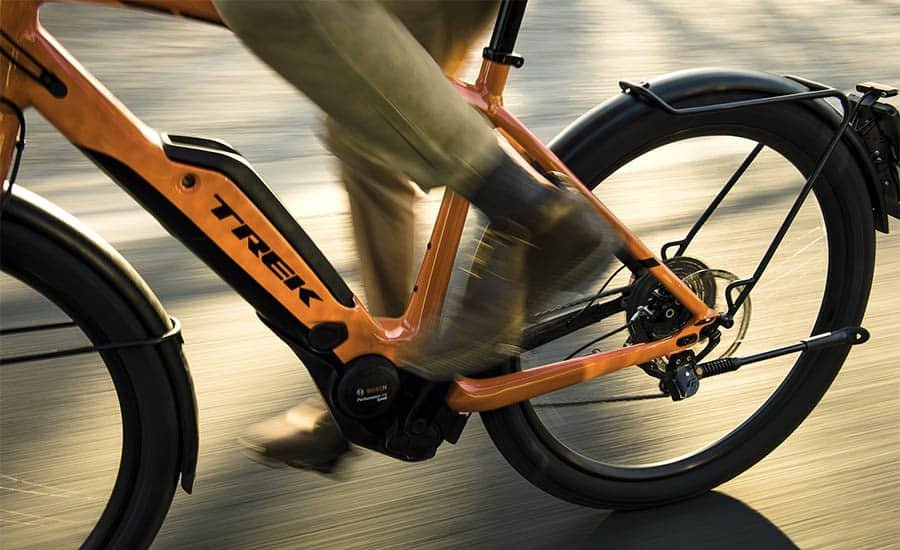Are you a racing enthusiast looking to try something new and exciting? Electric bikes may just be the answer you’re looking for! With their sleek design and advanced technology, electric bikes are quickly becoming a popular choice for both casual riders and professional racers.
But can these eco-friendly machines truly hold their own in the competitive world of racing? Or should we stick to the status quo and let traditional bicycles keep championing the world of competitive cycling? Well, let’s find out if the racing world has already embraced e-bikes, or if there are any hopes of them doing so in the nearest future.
In this article, we’ll explore the potential of electric bikes for racing and also examine the benefits and drawbacks of using them in various racing scenarios. So, if you’re curious about whether electric bikes can be used for racing, read on to find out more
Can You Race an E-bike?

This may surprise you, but people can race an e-bike in much the same way that they race traditional bicycles, with the added benefit of the electric motor providing pedal assistance to the rider.
In fact, the differences aren’t that significant. What majorly stands out is the fact that electric bikes are motor-powered, probably heavier, and come with special features that may reduce the overall efforts of the rider.
Additionally, e-bike racing typically takes place on off-road courses or on closed road circuits, and riders may compete in various formats such as individual time trials, multi-lap races, or mass-start events.
To participate in e-bike racing, riders typically need a specialized e-bike designed for the rigors of racing, which will feature high-performance components and an electric motor capable of providing a significant boost to pedaling power.
E-bike races are typically organized by the level of assistance the e-bikes provide, with different classes or categories for various levels of motor power and battery capacity. However, riders must follow rules regarding equipment, conduct, and course markings, and they may be subject to penalties or disqualification for violating these rules.
Overall, e-bike racing is an exciting and rapidly-growing sport that offers a unique and thrilling experience for riders of all skill levels.
What Speed Can You Do on an Electric Bike?

The top speed of an electric bike (e-bike) can vary depending on a number of factors, including the power of the electric motor, the weight of the rider and the bike, the terrain on which the e-bike is being ridden, etc.
Typically, e-bikes are designed to provide assistance up to a maximum speed of 20 to 28 mph (32 to 45 km/h). This speed limit is usually enforced by local regulations in the areas where e-bikes are used. However, some high-end e-bikes can reach speeds of up to 45 mph (72 km/h) or more.
It’s important to note that the speed of an e-bike may also be limited by the type of battery used and the amount of charge it has. As the battery level decreases, the e-bike’s top speed may be reduced as well.
It’s also worth noting that laws and regulations regarding e-bikes vary by country and region, so it’s important to familiarize yourself with local laws before riding an e-bike on public roads or paths.
Types of Electric Bikes Suitable for Racing

There are several types of electric bikes (e-bikes) that are suitable for racing, depending on the type of racing and the rider’s preferences. Here are some of the most common types of e-bikes used for racing:
🔲 Electric Road Bikes: Electric road bikes are designed for use on smooth, paved surfaces and are optimized for speed and efficiency. These bikes feature lightweight frames, narrow tires, and aerodynamic designs, making them ideal for road racing.
🔲 Electric Mountain Bikes: Electric mountain bikes are designed for off-road use and feature sturdy frames, wide tires, and advanced suspension systems. These bikes are ideal for mountain bike racing, as they offer excellent traction and stability on rough terrain.
🔲 Electric Cyclocross Bikes: Electric cyclocross bikes are designed for racing on a combination of paved and off-road surfaces. They feature lightweight frames, narrow tires with more traction than road bikes, and a more upright riding position. These bikes are suitable for cyclocross racing and can handle rough terrain and obstacles.
🔲 Electric Gravel Bikes: Electric gravel bikes are similar to cyclocross bikes but are optimized for longer distance rides on gravel and mixed surfaces. These bikes typically have wider tires, more relaxed geometry, and are designed for stability on rough terrain. They are suitable for gravel racing and endurance events.
🔲 Electric Fat Bikes: Electric fat bikes have oversized tires that provide excellent traction and stability on soft surfaces like snow, sand, and mud. These bikes are suitable for fat bike racing, a type of off-road racing that takes place on snow, sand, or other soft surfaces.
Rules and Regulations for Electric Bike Racing

The rules and regulations for e-bike racing can vary depending on the race organizer, the type of race, and the region or country where the event is being held. However, here are some common rules and regulations that apply to e-bike racing:
🔲 Equipment Requirements: E-bikes used for racing must meet certain equipment requirements, such as a maximum motor power output and a specific weight limit. Additionally, riders are required to wear appropriate safety gear, such as helmets and gloves.
🔲 Age Requirements: Most e-bike racing events have minimum age requirements for participants, typically 18 years or older. Some events may have separate categories for younger riders.
🔲 Course Regulations: Riders must adhere to course regulations and markings. In some cases, riders may be required to dismount and carry their bikes over certain obstacles or sections of the course.
🔲 Conduct: Riders must adhere to a code of conduct that promotes fair play, safety, and good sportsmanship. This includes following the rules of the race, showing respect for other riders and officials, and avoiding dangerous or reckless behavior.
🔲 Anti-Doping Measures: Some e-bike racing events may have anti-doping measures in place to prevent the use of performance-enhancing drugs or substances. Riders may be subject to drug testing before or after the race.
🔲 Local Regulations: E-bike racing events may be subject to local regulations regarding noise, environmental impact, and safety. Event organizers must comply with these regulations to ensure the safety of participants and spectators, and to minimize the impact on the local environment.
Top Electric Bike Racing Events Around the World

There are many electric bike (e-bike) racing events around the world, but here are some of the top events that attract a large number of participants and spectators:
🔲 Bosch eMTB Challenge: The Bosch eMTB Challenge is a series of e-bike races held in various locations across Europe, featuring challenging off-road courses and steep climbs. The races are open to riders of all levels, with different categories for men and women.
🔲 Enduro World Series: The Enduro World Series is a series of mountain bike races held in various locations around the world, including some e-bike races. The races feature technical terrain, steep descents, and challenging climbs, and are open to professional and amateur riders.
🔲 Electric Bike Expo: The Electric Bike Expo is a series of events held in various cities across the United States, featuring e-bike demos, test rides, and learning sessions. The Expo offers an opportunity for riders to try out a variety of e-bike models from different manufacturers. However, it’s not a racing event per se, but more like a train of roadshow events where people can learn, have fun and enjoy the e-bike cycling experience in a supervised environment.
Safety Considerations When Racing Electric Bikes

When racing electric bikes, safety should be a top priority for all riders. Here are some important safety considerations to keep in mind:
🔲 Wear appropriate safety gear: All riders should wear appropriate safety gear, such as a helmet, gloves, and protective clothing, to minimize the risk of injury in case of a crash.
🔲 Familiarize yourself with the course: Before the race, take time to familiarize yourself with the course and any potential hazards or obstacles. Pay attention to any warning signs or markings on the course.
🔲 Follow the rules of the race: Follow all rules and regulations set forth by the race organizer, including any speed limits or restrictions on passing.
🔲 Ride within your limits: Know your own limits and ride at a pace that you are comfortable with. Don’t push yourself beyond your abilities, especially on technical or challenging sections of the course.
🔲 Maintain your e-bike: Make sure your e-bike is properly maintained and in good working order. Check the brakes, tires, and other components before the race to ensure they are functioning properly.
🔲 Stay alert and aware: Stay alert and aware of your surroundings at all times, and be prepared to react to sudden changes in the course or the actions of other riders.
🔲 Be respectful to other riders: Show respect to other riders and avoid aggressive or dangerous behavior that could put yourself or others at risk.
Future of Electric Bike Racing and Its Impact on the Cycling Industry

It’s safe to say that the future of electric bike racing looks promising. With increasing interest and participation from riders around the world we can expect to see more e-bike racing events and competitions at both the amateur and professional levels.
One of the biggest impacts of electric bike racing on the cycling industry is the potential to attract a new demographic of riders who may not have previously been interested in traditional cycling. Plus, e-bikes make cycling more accessible to a wider range of people, including those who may not be able to ride long distances or tackle challenging terrain on a traditional bike.
This increased accessibility can lead to growth in the overall cycling industry, as more people become interested in cycling and purchase e-bikes. Additionally, e-bikes can have a positive impact on the environment and sustainability.
As more people choose to ride e-bikes instead of traditional vehicles, there is also the potential to reduce carbon emissions and promote sustainable transportation. Another impact of e-bike racing on the cycling industry is the development of new technology and innovations in e-bike design.
E-bike racing provides a platform for manufacturers to showcase their latest advancements in e-bike technology, which can then be applied to other areas of the cycling industry.
Overall, the future of electric bike racing looks bright, and its impact on the cycling industry is likely to be significant. As e-bikes become more advanced and accessible, we can expect to see continued growth in e-bike racing and a positive impact on the cycling industry as a whole.
FAQs
What are the disadvantages of using an electric bike for racing?
In general, electric bikes are often heavier than traditional bikes, which can make them harder to maneuver. Additionally, the battery may run out of power during a race, leaving the rider at a disadvantage.
Can electric bikes be modified for racing?
In certain cases, electric bikes can be modified to increase their speed and performance. However, it’s important to note that certain modifications may not be legal in some racing events.
What kind of electric bike is best for racing?
Ultimately, the best electric bike for racing will depend on the specific race and the rider’s preferences. Some popular options include road bikes, mountain bikes, and hybrid bikes.
Are electric bikes faster than traditional bikes?
Electric bikes can be faster than traditional bikes, as they provide power assistance to the rider. However, the maximum speed and acceleration will depend on the specific model and the rider’s skill level.
How do electric bikes compare to traditional bikes in racing?
Electric bikes can provide power assistance to the rider, which can give them an advantage in certain types of races, such as hill climbs or time trials. However, in other types of races, such as criteriums or road races, traditional bikes may have an advantage due to their lighter weight and greater maneuverability.
Can electric bikes be used in triathlons?
It depends on the specific triathlon and the regulations in place. Some triathlons may allow electric bikes to be used in certain categories or events, while others may only allow traditional bicycles.

